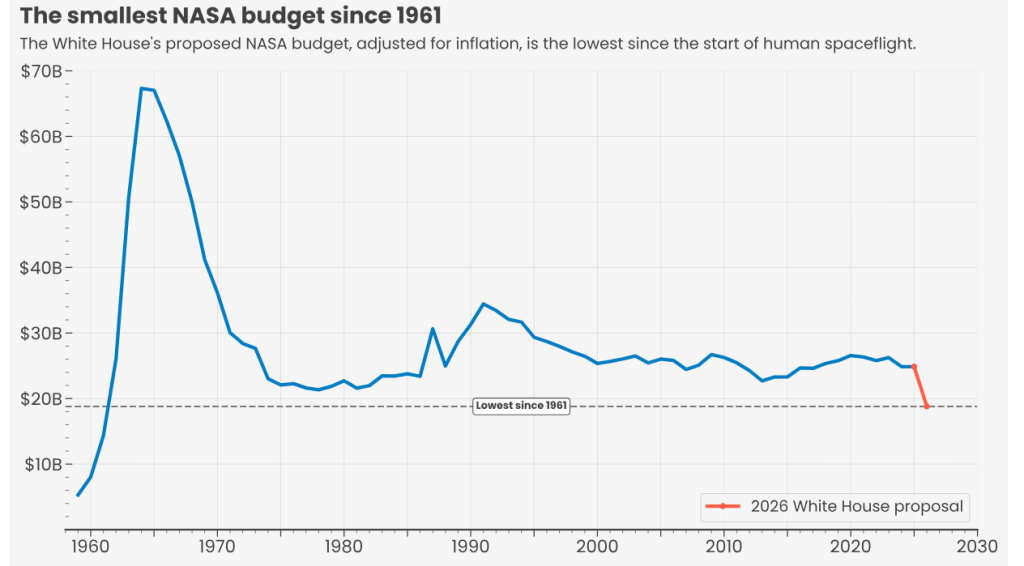NASA’s civil servant workforce has varied in size over the years, peaking during the Apollo program. During the 1990s, the Clinton administration reduced the workforce by 25% over five years, a process that some claim laid the groundwork for the shuttle Columbia disaster. This budget proposes to slash NASA’s workforce by nearly 1/3 in a single year via involuntary layoffs, resulting in the agency’s smallest workforce since fiscal year 1960, before NASA’s Marshall Space Flight Center, Johnson Space Center, and Stennis Space Center even existed.
In pretty pictures:

No. SpaceX doesn’t make up for this. China does both, massive public spending and multiple space launch companies.
Space-Based Solar Power (SBSP or SSP), the concept of gathering solar power in space using solar power satellites (SPS) to send it back to Earth, may sound like science fiction, but it is getting closer to reality.
China plans to build a 1km-wide solar array in the geostationary orbit about 36,000km above Earth.
At this distance from atmospheric interferences such as day-night cycles and changing weather, the array will constantly gather solar energy, anticipated to surpass terrestrial photovoltaic systems by more than tenfold in efficiency.
Once collected, this energy will be transformed into microwaves and transmitted to a ground-based collector station.
Colloquially known as a powersat, this was suggested by O’Neill back in the 70s. It could have been done with tech that within reach in about a decade, but, of course, America did no such thing. The space shuttle cost way too much to launch, funding had dried up to do things better and cheaper and space was no longer a priority.
China’s following O’Neill’s playbook, weirdly enough. They’re doing what the US decided not to do. To put it bluntly, if humanity has a future in space, it will be Chinese, not American. This isn’t primarily about colonization, though some people will live in space for a time, it is about putting manufacturing, refining and mining into space so we can re-wild the Earth, and avoid the resource trap.
It’s not a sure thing, by any means, but given that Earth is limited and space is much less limited, it’s the only way out of the limited resource trap. China either succeeds (and it’s them or no one, because there is a ticking clock) or we face inevitable civilization collapse. Once that occurs, having already mined all the easily accessible resources, there is unlikely to be a second chance at a future in space, or even a particularly high tech society.
Anyway, as usual, the future happens in China, and America has given up. AI is bullshit, even if it works, American capitalists want it so they can put a third of the workforce out of work. Meanwhile China builds civilian robots, automates entire factories and ports, has flying cars and drones galore and is actually working towards a real future in space.
We’re about 3 weeks into our annual fundraiser. Our goal is $12,500 (same as last year). So far we’ve raised $9,235 from 82 people out of a readership of about 10,000.
If you read this blog, you’re usually ahead of everyone else. You know, years in advance, much of what’s going to happen. The intelligence from this blog is better than what people pay $10,000/year for. Without donations and subscriptions, this blog isn’t viable. If you want to keep it, and you can afford to, please give. If you’re considering a large donation, consider making it matching. (ianatfdl-at-gmail-dot-com).
